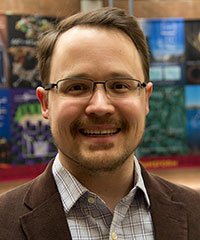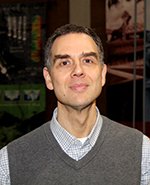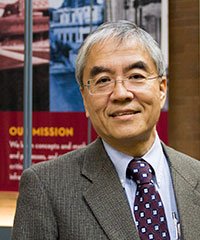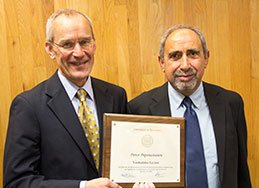Warren Distinguished Lecture Series

The Warren Distinguished Lecture Series is made possible by a generous, renewing gift by Alice Warren Gaarden in 1961. Since 1989, we have been bringing in accomplished researchers and speakers from around the world to share their work with students, faculty, and friends of CEGE.
NOTE: The series will resume after a summer break. Please review our recordings of past sessions linked below!
Upcoming Events
The series will resume after a summer break. Please review our recordings of past sessions linked below!
There are no upcoming events matching your criteria.
Past Warren Lectures
Reductive Dissolution and Metal Transport in Subsurface Sediments: A Modeling Approach
Friday, Feb. 17, 2017, 10:10 a.m. through Friday, Feb. 17, 2017, 11:15 a.m.
George J. Schroepfer Conference Theater, 210 Civil Engineering Building

Sevinc Sengor
Civil and Environmental Engineering, Southern Methodist University
ABSTRACT: Heavy metal toxicity has been observed in various aqueous systems, including rivers, lakes and marine waters. Most of these metals are toxic and carcinogenic to biota, including humans, such that significant negative human and ecological impacts result from metal-enriched dust, soil and water. It is vital to understand and quantify the biogeochemical reactions controlling the fate and transport of these metals to effectively model and predict changes in metal concentrations and microbial populations with respect to time and space. Sengor presents examples that cover a range of biotic and abiotic geochemical processes typically encountered in shallow subsurface environments, such as redox disequilibrium, reductive dissolution, sorption/desorption and co-precipitation, supporting innovative strategies to reduce human health risks and environmental damage from metal contaminated sites.
The Nitrogen Challenge: New Players, Processes, and Paradigms in the Quest for Sustainable Nutrient Pollution Prevention
Friday, Feb. 3, 2017, 10:10 a.m. through Friday, Feb. 3, 2017, 11:15 a.m.
George J. Schroepfer Conference Theater, 210 Civil Engineering Building

George Wells
Civil and Environmental Engineering, Northwestern University
ABSTRACT: Nitrous oxide emissions and energy-intensive operation are hallmarks of conventional wastewater treatment plant bioreactors that rely on the microbial processes of nitrification and denitrification to remove reactive N from wastewater. However, the last two decades have seen the emergence of several novel microbial ‘players’ in the global biogeochemical N cycle. In this talk, Wells details three examples of what he and his colleagues are doing to leverage new understanding of community dynamics and metabolic versatility in the microbial world to enable low-energy, sustainable bioprocesses for N pollution prevention.
The Interaction of Hydraulic Fractures with Natural Fractures: An Experimental View
Friday, Jan. 27, 2017, 10:10 a.m. through Friday, Jan. 27, 2017, 11:15 a.m.
George J. Schroepfer Conference Theater, 210 Civil Engineering Building

Jon E. Olson
Petroleum and Geosystems Engineering, University of Texas at Austin
ABSTRACT: The incredible increase in oil and gas production in the United States can be largely attributed to the application of horizontal wells and hydraulic fracturing to organic-rich shales. One aspect of the hydraulic fracturing in these formations that seems unique is the apparent complexity of the induced fracture propagation. Some of this complexity has been attributed to the intersection and diversion of the hydraulic fracture by pre-existing natural fractures and faults. We investigated the attributes that control failure for calcite cemented veins in subsurface core samples of Marcellus shale using the Semi-Circular Bend Test. Experimental results show that the approach angle of the propagating fracture relative to the vein has a strong influence on whether the fracture-fracture interaction results in crossing or diversion. The likelihood of diversion can be explained using the Energy Release Rate criterion. Other parameters that were investigated include the vein thickness, fracture toughness and Young’s modulus. Numerical modeling work is underway to probe a wider range of parameters than is possible with physical samples. This work is utilizing the Distinct Element Method code PFC3D.
Diffusion in Composite Media with Close-to-touching Inclusions
Friday, Jan. 20, 2017, 10:10 a.m. through Friday, Jan. 20, 2017, 11:15 a.m.
George J. Schroepfer Conference Theater, 210 Civil Engineering Building

Eric Bonnetier
University Joseph Fourier, Grenoble, France
ABSTRACT: Bonnetier and his colleagues study an integral formulation of a diffusion equation in a 2D composite medium containing inclusions with smooth boundaries, which can be close to touching. Their objective is to study the possible blow-up of the gradient of the field in terms of two parameters: the material coefficient contrast and the distance between the inclusions. They reformulate the problem via an integral representation and relate the behavior of the gradient to the spectral properties of the corresponding integral operator, the Neumann-Poincare operator, as these parameters degenerate.
(Sorry, video not available.)
1,000 Words ≤ 1 Picture << 20,000,000 DNA Sequences
Friday, Dec. 2, 2016, 10:10 a.m. through Friday, Dec. 2, 2016, 11:15 a.m.
George J. Schroepfer Conference Theater, 210 Civil Engineering Building

Timothy LaPara
Civil, Environmental, and Geo-Engineering, University of Minnesota
ABSTRACT: Over the last 10 years, the development of single-molecule, high-throughput DNA sequencing technology has drastically improved the ability of microbiologists to characterize bacterial communities. In this presentation, LaPara discusses two examples in which next-generation DNA sequencing technology was used to investigate bacterial community composition in drinking water systems. He shows that the application of next-generation DNA sequencing technology enables new insights into the microbiome of drinking water treatment and its subsequent distribution to water consumers.
10 Sextillion Atoms
Friday, Nov. 18, 2016, 10:10 a.m. through Friday, Nov. 18, 2016, 11:15 a.m.
George J. Schroepfer Conference Theater, 210 Civil Engineering Building

Ellad Tadmor
Aerospace Engineering, University of Minnesota
ABSTRACT: In most engineering applications the material is a continuum “black box” represented by a constitutive model (like Hooke’s law) fitted to experimental observations. In reality a material is a complex dynamical system consisting of atoms (nuclei and electrons). There are about 10 sextillion (1022) atoms in a gram of copper. The typical separation between atoms is of the order of 1 angstrom (10-10 meters) and the characteristic time scale of atom vibration is 1 femtosecond (10-15 seconds). The challenge is to construct predictive constitutive relations for a material from the atoms up. This leads to many questions. How can we reliably predict the interactions between the atoms when there are too many for quantum mechanics to be used? How do we deal with the exponential complexity of the atomic energy landscape? How do we address the huge spatial and temporal scale disparities from the atomic to the macroscopic? How do we relate macroscopic concepts like stress and heat flux to the microscopic processes in a solid? How can non-equilibrium processes be modeled? These are the basic questions being explored today in the emerging field of multiscale science and engineering. In this talk, we will discuss the theoretical and computational methods being developed to address some of these issues.
Photochemical Fate of Lampricides in Tributaries of the Great Lakes
Friday, Nov. 11, 2016, 10:10 a.m. through Friday, Nov. 11, 2016, 11:15 a.m.
George J. Schroepfer Conference Theater, 210 Civil Engineering Building

Christy Remucal
Civil and Environmental Engineering, University of Wisconsin-Madison
ABSTRACT: Lampricides have been intentionally added to tributaries of the Great Lakes since the 1950’s to kill the invasive parasitic sea lamprey. This direct application of lampricides into the Great Lakes ecosystem is in contrast to legacy contaminants and many chemicals of emerging concern. Despite the widespread and intentional use of lampricides TFM and niclosamide, their fate in the environment is poorly understood. Remucal performed laboratory experiments to assess the susceptibility of both compounds to direct and indirect photochemical degradation. While the direct photodegradation rates of TFM are orders of magnitude faster than those of niclosamide, both compounds eventually undergo dehalogenation during direct photolysis. The presence of dissolved organic matter increases the photodegradation rate of niclosamide through the production of a series of reactive oxidants. In contrast, TFM is not susceptible to indirect photolysis. In addition, Remucal conducted two field campaigns to quantify TFM photolysis during lampricide applications in 2015 and 2016. From these two field campaigns, it is illustrated that TFM in both small and large systems may enter the Great Lakes with minimal photodegradation, which has important implications for Great Lakes ecosystems.
A Three-level Location-inventory Problem with Correlated Demand
Friday, Nov. 4, 2016, 10:10 a.m. through Friday, Nov. 4, 2016, 11:15 a.m.
George J. Schroepfer Conference Theater, 210 Civil Engineering Building

Avinash Unnikrishnan
Civil and Environmental Engineering, Portland State University
ABSTRACT:Supply chain networks serve as the basis of operation for many industries. In today’s competitive market, with its risky and uncertain operational environment, it is important to design supply chain networks in a cost-effective, efficient, and responsive manner. Unnikrishnan considers a three-level supply chain comprising plants, warehouses, and retailers, and presents a three-level location-inventory problem with correlated demand, which simultaneously minimizes the total cost for three types of decisions: (i) location of warehouses and plants, (ii) assignment of warehouses to the plants and the assignment of retailers to the warehouses, and (iii) optimal inventory level and safety stock cost at the warehouses. The initially-proposed binary nonlinear integer program (BNIP) formulation is transformed into a mixed integer conic quadratic program (MICQP). This transformation is performed to exploit the advances made by solvers such as CPLEX in solving second order conic integer programs. A solution approach based on an outer approximation strategy is proposed and the algorithmic advantage of such a framework for this class of programs is demonstrated. The results from numerical experiments show that the proposed solution procedure clearly outperforms state-of-the-art commercial solvers. In addition, the research shows that neglecting the effect of correlation can lead to substantially sub-optimal solutions.
Experimental and Computational Investigation of the Seismic Performance of Reinforced Concrete and Masonry Structures
Friday, Oct. 28, 2016, 10:10 a.m. through Wednesday, Oct. 26, 2016, 11:15 a.m.
George J. Schroepfer Conference Theater, 210 Civil Engineering Building

P. Benson Shing
Structural Engineering, University of California, San Diego
ABSTRACT: The ability of reinforced concrete and masonry structures to resist high-intensity earthquake ground motion depends on many factors, including the reinforcement details, such as the quantity and distribution of the reinforcement, how well the concrete or masonry material is confined, how the structural components are connected with each other or anchored to the foundation, the geometric configuration and the level of redundancy of the seismic load-resisting system, and the interaction of structural and non-structural elements. Shing summarizes some of the recent experimental and computational studies carried out by his research group on the improving the seismic performance of reinforced concrete bridge structures and reinforced masonry buildings.
The Role of Plastic Deformation in Hydraulic Fracturing
Friday, Oct. 21, 2016, 10:10 a.m. through Friday, Oct. 21, 2016, 11:15 a.m.
George J. Schroepfer Conference Theater, 210 Civil Engineering Building

Special Warren Lecture in Honor of Ioannis Vardoulakis
Panos Papanastasiou
Civil and Environmental Engineering, University of Cyprus
ABSTRACT: Among the outstanding technical issues in hydraulic fracturing is prediction of the fracturing pressure and fracture geometry. Related issues appear in CO2 geological storage, as there are risks of hydraulic fracturing and CO2 migrating into upper formations and to the atmosphere. Papanastasiou will present results obtained from modeling hydraulic fracturing in weak formations. The work was carried out with a fully coupled elastoplastic hydraulic fracturing numerical model, and later it was extended to analytical work based on a Mohr-Coulomb dislocation model, in which the complete slip process distributed around the crack tip was replaced by superdislocations placed in the effective centers of plastic deformation. (Pictured: Joseph Labuz (left) presents Papanastasiou (right) with a plaque commemorating the 2016 Vardoulakis Lecture.)